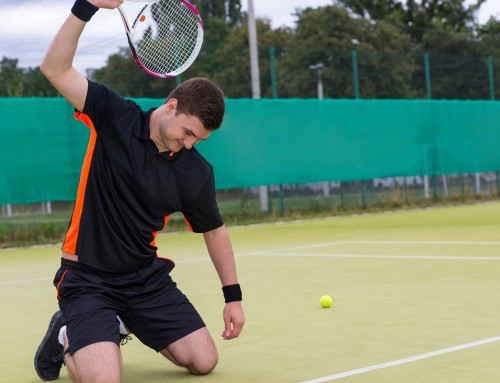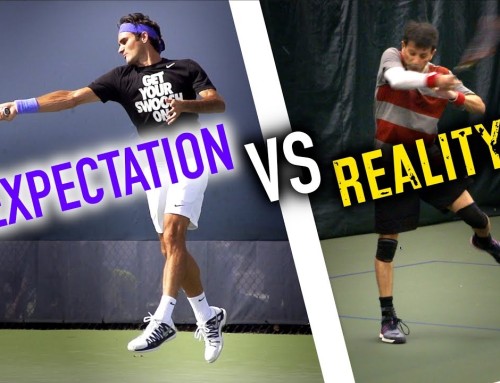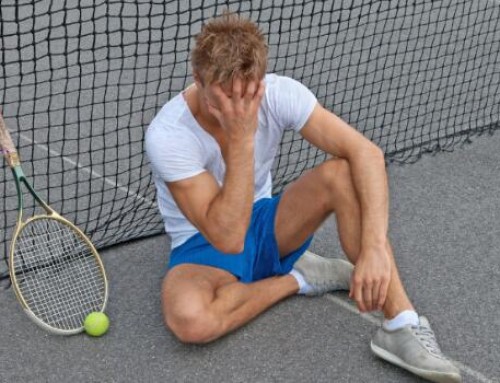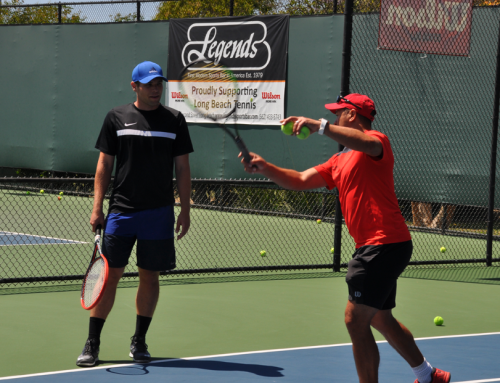Today’s podcast episode is on an awesome topic: at what point in your tennis development should you stop being so focused on being steady and start developing some big weapons? Is there a certain level that you should transition over? Are their specific cues in your game that you should be looking for? I talk about the “sliding scale” of tennis players on this episode and give advice on what to develop and when based on your current level of play!
Download Transcript: Word Doc | PDF | Kindle | Text
Welcome to the Essential Tennis podcast. If you love tennis and want to improve your game, this podcast is for you. Whether it’s technique, strategy, equipment, or the mental game, tennis professional Ian Westermann is here to make you a better player. And now, here’s Ian.
Ian Westermann: Hi and welcome to the Essential Tennis podcast, your place for free expert’s tennis instruction that can truly help you improve your game. Today’s episode of the podcast is brought to you by Tennis Express. Please check them out this week by going to EssentialTennis.com/Express
Well, thanks very much for joining me on today’s episode. I really appreciate having you as a listener. And before we get to today’s topic, which is going to be working on the difference between consistency and power and which should you work on more and when, which is a good topic, I want to let you know that next week I’m going to have an announcement to make.
Not quite as big as my last one I guess, but I’ll just tell you it’s going to have to do with Essential Tennis Platinum, which is my monthly membership section of EssentialTennis.com. I haven’t made it available for quite a while now, and I’m going to kick off something having to do with that next week. That’s going to involve a free video course about improving several strokes of your tennis game.
And that course is only going to be available for a limited time, so I’m giving you a week’s heads up on that. Next week I’m going to announce that. I’m going to tell you exactly where to go to get that free course, and at the end of next week I’m going to be opening Essential Tennis Platinum again for a short period of time to new members. So I wanted to give you all a week’s heads up on that. Look for that. Listen to that. Next week I’ll have more details. With that, let’s go ahead and get to today’s show. Sit back, relax, and get ready for some great tennis instruction.
Let’s get to day’s topic which comes to us from Joe Shelton, and I don’t have his location, but we see here from his question that he’s a 4-70 player. He’s got a quick and simple question that’s really good. He wrote and said as a 4-0 player aspiring to be a 4-5 level which is better? Working to be more consistent or working to hit more powerful shots? They aren’t mutually exclusive, but there definitely is a tradeoff. I’m thinking specifically forehands in my case, but in fact the question applies to the full spectrum of the game.
Yeah, Joe, good question. I agree with several things that you said there in your question. First of all, you’re right. They aren’t mutually exclusive, meaning it doesn’t have to be either/or. You don’t have to work on either consistency or power. In fact obviously it would be great to have both to consistently be able to hit powerful shots, but I agree with you there is a tradeoff there, and all of us only have certain amounts of time to work on our game. So you have to try to choose what’s the wisest aspect of tennis to spend your time on that you really improve the part of your game that’s most relevant to actually making the jump to the next level.
You don’t want to work and spend your valuable time on court on something that is a waste of time for your level, and maybe it’s a good concept and not a waste of time, but it’s something that maybe didn’t have the biggest effect on your level that could’ve been if you worked on something more relevant. So, good question here Joe.
I’d like to start off by saying that there’s a sliding case. What you want to spend more time on really depends on what level your game is at, and I’m going to describe that for the benefit of everybody listening to the episode. And then towards the end after I give a general description so that the entire audience can benefit from hearing my thoughts on this. After that I’m going to give you my thoughts specifically for your level, but you’ll be able to deduce that based on the general outline that I give based on different levels of play.
Basically the way this works is beginners on up through right around your level of play, I think right around a 4-0 level or maybe a stronger 4-0 level should definitely be focusing mostly on consistency. And obviously it’s not bad if you have weapons at a 3-0 level. If you’re blessed with good athleticism and are able to hit the ball hard without even really trying to, then great. Most people listening to this hate you by the way if that’s the case. If you just pick up the game and are able to immediately have weapons, awesome, but regardless of that when you’re beginning and on up through probably a 4-0 level, you should be working on consistency.
And there’s three reasons for that in my estimation. Number one, power isn’t needed to win. So just purely from a tactical standpoint, you have to realize that at a beginner level on up to a 3-5 level for sure, the vast majority of points end in error. They end in somebody just making a mistake, and they weren’t forced to mess up. It wasn’t a forced error. That’s a shot when your opponent hits a great shot that you get to, and you get a racket on it, but it was such a good shot that you just weren’t expected to make that shot back in play. And up through a 4-0 level, the vast majority of points end with someone making a mistake.
So just from a purely tactical standpoint, focusing on your consistency and just being able to place the ball accurately in the court where you wanted to go over and over again, that’s how you’re going to make the biggest jump in level. Joe has already done that. He’s already put in the leg work to get to that point. He’s a 4-0 level, which is a more advanced player for sure. Certainly intermediate, and he’s put himself now I think in the top 15% or 20% players in the United States, which is awesome. So he’s obviously put in the time and the repetition to be able to put the ball in the court. Otherwise he wouldn’t be a 4-0 looking to improve to 4-5 in the first place. So, nice job with that Joe.
Reason number two why up until Joe’s level you want to focus on consistency is because if you ever want to reach a 4-5 level, which is definitely classified as advanced. We’re talking about the top 5% to 10% of players in the US. You need a solid base. You need a solid foundation of just knowing how to get the ball in play reliably. If you start off your tennis journey early on working on weapons and working on racket head speed and working on big amounts of spin and big amounts of power, you’ll probably be able to come up with a great impressive shot here and there, but more than likely you will also make a lot of unforced errors that kind of counter balance the awesome shots that you do make.
So you should really put a strong emphasis on consistency first so when you do get into a match and you get closer to the more advanced level of play, you have a good base of just being able to get the ball in play first. And then from there you’re able to work the point. You’re able to transition smoothly from more of a neutral rally to offense. Instead of only having offense and having started your tennis career just developing weapons and just having offense, and when you walk out there and don’t have a great day which is what it takes.
If all you have is offense and that’s all you have to fall back on and you have even a little bit of an off day, you’re going to make mistakes all over the place. And when that happens and you don’t have that fundamental base to fall back on of just being able to just hit the ball in the courts and just work a point and be patient and play the ball safely. If you don’t have that, then your only way of winning is hoping that your opponent makes more mistakes than you do. Or obviously hope that you have a good day. And when you have a good day and those are your tactics, it’s going to be a great day. You’re going to hit winner after winner. Everything is going to feel great, but when you’re that type of player and you have the foundation, then having an off day can be just a disaster. And you don’t want to play that kind of all or nothing style. You won’t have any staying power. You won’t have any consistency. So that’s number two. We need that solid base.
Then number three, the only way to be consistent and accurate is through good fundamental technique. And so if early on you have the patience to work on your consistency, the only way to really do that reliably is to have good solid technique. I should temper that by saying it’s possible to hit the ball in the court without having traditional technique, or what people would call good looking technique. It’s certainly possible to do that. I’m not going to say you have to have X, Y, and Z technique in order to be a good tennis player. That’s not the case.
There’s a lot of different types of people out there, a lot of different types of athletes, people learn that differently and might not be interested in making everything try to look right, and that’s okay. I just want to throw that out there, but in general if you want to move down a path of improvement then making fundamentally sound technique improvements is really necessary. It’s something you have to do.
When you put a high value on consistency, the best and really for most people the only way to do that is to also work on your technique. So when you work on that early on, you’ll learn how to create consistent repeatable strokes, ground strokes, volleys, serves, returns of serves, everything you need to be a good player. When you focus on that, all of those different techniques will become kind of galvanized through repetition, and this again forms a solid foundation to your game.
So you develop that consistency. You develop your stroke technique, and what I’m describing is really the way that I recommend to all of you listening that are beginners or maybe 3-0, 3-5 type of players. These are the things you should be focusing on, your stroke technique, your consistency. These are the things that give you a solid base to work on and improve from there to more advanced levels of play.
So that’s kind of the general overview of how you should be thinking of you’re a beginner player or starting off tennis. Maybe you’ve been playing a couple of years and you’re a 3-0 or 3-5 player. Once you get up to around where Joe is, a 4-5 level, and definitely a stronger 4-0 level, winning becomes less about just getting the ball. There’s kind of a transition that occurs. By the way there isn’t like a set level where everybody makes this magical transition to be an advanced player. It’s different for everyone, but I’m using a general level which is right around where Joe is, right around a 4-0 level where most players will find that they can’t continue to be successful unless they have some type of offense. And who wins and loses matches starts becoming more about who dictates play, who is more in control of the points.
Just getting the ball in place is no longer enough to control the outcome of the match because now we’re playing players who are advanced enough that they have weapons and offense of their own. And so if you just get it in play, you will find that they will start to take over, and they will take the match from you. Whereas previously at lower levels if you just got the ball in play, eventually your opponent would just screw up. And if you could just get them to just screw up enough times you would win the match. Joe is starting to get that level where he can’t rely on that anymore, and definitely a half level up from where he is now, he won’t be able to do that anymore.
I’ll just give you a quick example of how this works. After having quit my job, and I’ve now been out on my own for 3 weeks now. This is my 4th week. Today is Monday. A goal of mine was to get back in shape again. You might think being a tennis teaching pro I’d be in incredible shape because I’m out on a tennis court every day all day long. Well, the hitting that I do with clients is much, much less strenuous than what I would do if I was actually competing. Most of my clients were an average level player, so we’re talking 3-5 level, and that compared to playing at a 5-0 level is completely different.
So my strength and my conditioning over the last 5 years have continued to decline. My timing, my coordination, my focus, my concentration, these are all things that have all been on the decline over the last several years as I’ve spent all my time on the court teaching and not actually playing at the level that I’m accustomed to competing at when I’m in full form. So anyway it was my goal to get out and start playing again and start working out when I finally quit my job and could make my own schedule, and I’ve started doing that.
In my first week out on my own, I set up some hitting time against a player who plays the top spot in a local 4-5 level team, and it was really frustrating for me because I was kind of between a rock a hard place. My body was physically weak. I didn’t have the strength I was used to having back when I was playing every day, and of course my timing, my consistency was not there because I’m just out of practice. It’s been a while since I’ve really competed. So my game is just not there.
Of course I came out during the first set we played just totally going for what I would typically go for if I was in good playing shape and if I was in good playing form, and I just made a lot mistakes and on easy balls. It’s not that I was going for shots that were totally like shots that I couldn’t make. They were shots that I should’ve made if I was in full playing form, but I was not. So I was missing them as a result.
So I thought I’m just going to get the ball in because I was dictating play but losing because I was making so many unforced errors. That’s a bad combination. Dictating play and losing points, so I was digging myself a hole score wise and was losing because I was making so many unforced errors. So I’m thinking okay I’ll be smart. I’ll just get the ball in play. I’m not going to be offensive. I’m just going to go for a rally ball and just make my opponent beat me. I shouldn’t beat myself and be dumb tactically.
So I did that, and my opponent beat me. I’m just saying this to illustrate my point. I slowed down and became less aggressive. I made way fewer mistakes, so I achieved my goal of being more consistent. I put the ball in play, and then my strong 4-5 level opponent dictated play because I wasn’t and beat me. So he started taking over the points offensively. He started hitting winners. He started pressuring me, running me around, and before I knew it the set was over.
So that’s just an example of how at a 4-5 level much less at a 5-0 level if you don’t have the goods, if you don’t have the weapons it doesn’t really matter how consistent you are. Your opponent will find ways to dictate play and use their weapons against you. So I just tell that story just to show you all exactly what I’m talking about.
Joe, to make it up to a 4-5 level, it won’t be good enough to just be consistent. So for you specifically, Joe, if you feel confident that you can rally steadily, and you’re solid, can keep the ball in play, and you feel confident that there’s no major holes technique wise in your game — what I mean by that is your forehand your solid. You can just rally that in play all day long, but your backhand is causing you problems. Technique wise it’s not just there, and you have a hard time getting the ball in play. Well, you should spend some time and shore up that backhand before you start worrying too much about weapons.
But if in general you feel pretty solid, and the rest of you listening if you’re around a 4-0 level and you feel pretty solid in general, off the baseline just rallying, keeping the ball in play, maintaining a neutral rally back and forth over and over and over again, then it’s time to start working on offense. If you don’t ever make that transition to start working on your weapons, then you’re not going to make it to a 4-5 level. You’re going to need it in order to be competitive at a 4-5 level. You got to have some kind of offense. Without that, you might be successful against the lower level 4-5 type guys who also don’t have weapons, but against the legitimate solid 4-5 and definitely against a stronger 4-5 level, just putting the ball in play is no longer good enough.
So, Joe, there you have it. It’s a sliding scale, and whether or not you should start focusing on weapons now is going to be determined on how solid you are in general right now with what you’re doing currently. If you feel confident that you’re solid right now, start working on more racket head speed, more power, more topspin to keep the ball in play and still be consistent and start working on picking up the level of your strokes. Best of luck doing that and definitely let me know how that goes. Thanks very much for being a listener and writing in with your question. I appreciate it.
Alright that does it for today’s question in episode 167 of the Essential Tennis podcast. In wrapping up, I want to read a couple of comments that listeners left on last week’s show in which I talked about defeating a serve and volley type player. I did some of that earlier by the way. I play that same 4-5 level opponent earlier. Played two sets against him outside for the first time this season. It was in the 80s and sunny, and it was a lot of fun playing outdoors on a hard court again. Successfully served and volleyed several times, which is one of my favorite tactics to use. So I look forward to continuing to hit. I’m sure I’ll have more stories, and I’m going to be telling you guys about my adventures especially since I’ll be playing in a league this coming summer, or at least part of the summer season, so I’ll be letting you guys know how that’s going.
Okay, comments from last week’s show about serving and volleying. From James, he said here’s a tactic Bjorn Borg used. He had trouble with Jimmy Connors at first. Then, instead of going for the quick winner, he started hitting his first shot right at Connors, jamming him, drawing a defensive first volley, and pinning him further back from the net. Then went for a pass on the second ball. And then he has a second suggestion. Change up your return position and/or pace. When I follow a serve in, I’m looking for a quick, reflex volley from a ball where I expect it. Hit a dipping return repeatedly, then on a key point, say 30-40, flatten it out, for one example. Just don’t use it on me
Yeah, James, both good suggestions. Your second one, mixing it up, kind of dipping it down at the feed, and then eventually going right at the body, that’s something I suggested in the episode, both of those tactics. And the first one, Borg versus Connors, I totally agree what you’re saying about setting up the point rather than going for the winner right away, which very often will lead to unforced errors. Be patient and don’t panic, which can be difficult to do when you know that your opponent is going to continue to come into the net, is going to continue to pressure you.
That’s exactly what a serve and volley player wants is for you as the returner to feel panicked and pressured and feel like you have to go for that perfect shot over and over again. Because that means that the serve and volley player, unless you’re really on that day, is going to get a bunch of free points from you going for that perfect ball off of that return. And you’re going to make lots of unforced errors off that return of serve. Again, unless you’re having a great return day in which case maybe it’ll work out for you. And that’s great if it does.
But what James is suggesting here is really smart, to think of it more as a setup, your return of serve. Don’t think of it as having to be a winner. Try to setup the eventual passing shot rather than feeling like you have to do it right away. That’s really smart.
And then Joanna. She left a comment referring to somebody else who also left a comment. She said I agree with Jason, who left several suggestions also in the comments. Thank you Jason. The return of serve lob is especially effective on those opponents who love to close in right away, especially if they skip the split step and charge the net. They often aren’t able to stop and back up quickly enough to cover the lob. It can be an easy point as well as a good way to keep them back.
Yeah, I agree, Joanna. Well, you’re not going to play a lot of players who serve and volley a lot who don’t use the split-step, who aren’t smart enough o use the split-step, but I take that back because I do see it all the time in intermediate and definitely in lower level doubles where players are trying to use a more offensive serve and volley tactic. And they think that they have to get as close as possible for the serve.
Just as Joanna said, and this is what Jason was saying in his comments as well, was that a player will totally skip the split-step, which is their method of balancing themselves, and just run essentially right underneath a lob, if you can hit a nice high deep lob. They won’t be balanced, and they won’t be able to change direction and get back soon enough to be able to get a racket on a well hit lob.
So if you notice that your opponent likes to come to the net and is kind of playing and all or nothing style, just crashing in, absolutely the lob. If you’re playing somebody who is a little bit smarter than that and after beating them once or twice starts balancing themselves and using the split-step, then you’ll have to mix things up a little bit. Unless of course their overhead is not, in which case by all means just go ahead and continue to lob.
But against a more intermediate or advanced level serve and volley player, you’re going to have to mix things up a bit more, keep them off-balanced. Using the lob is not going to be very effective right off the return against an advanced player because they are split-stepping, and usually that split-step is being made several steps behind the service line still. On the service line would be really close because usually these players have bigger serves, so they don’t have a lot of time to get close to the net.
So lobbing right off the bat when they’re two-steps behind the service line is not going to be effective. You’re going to have to hit the ball on the baseline in order to really challenge them since they’re not even close to the net yet by the time you hit that return of serve. So in that case, you want to let them get a little bit closer, maybe two or even three shots into the point and then using the lob, instead of using it right off the return. But, Joanna, you’re right. If they don’t split-step by all means use it. It probably will be effective.
Okay, so Jason, Joanna, James, lots of Js there. Thank you very much for leaving your comments, and if you have comments about today’s episode, 167, please leave a comment. You can do that by going to EssentialTennis.com/Podcast, click on episode 167, and leave your comments below the transcript for this episode. I definitely read all of those. I don’t always respond to all of them, but I do my best to. And I love to hear what you have to say about today’s episode.
In wrapping up, I want to remind you about my sponsor. It’s been a couple of weeks since I done that. Please go check out Tennis Express, one of the best online tennis retail stores you can go to. They have a really great selection of rackets, strings, bags, clothing, etcetera, shoes, really good prices, and you can get free shipping on orders of $75. I’d appreciate it if you checked them out by going to EssentialTennis.com/Express. That’ll shoot you right on over to Tennis Express, and it’ll also track any orders that you might make. And if you do that, I’ll get a small percentage coming back to the podcast to help support the show.
To all those of you who have been purchasing through that link, I really appreciate it. Definitely helps me pay the bills here at Essential Tennis studios. So thank you very much for your support. Alright that’s this week’s show. Thanks very much for listening. Take care and good luck with your tennis.







